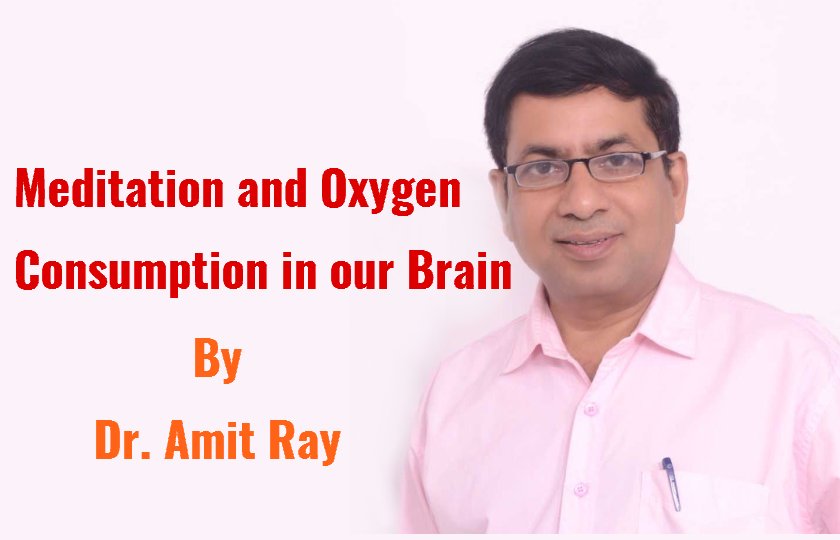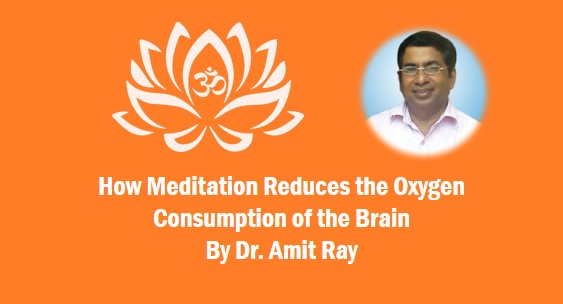How Meditation Lowers Oxygen Consumption and Repair Brain Damage
Dr. Amit Ray
“Meditation is the artwork to awaken the divinity within you.” – Amit Ray
Meditation improves long-term ventilatory efficiency, gas exchange efficiency and heart rate variability by lowering oxygen consumption and enhancing the divinity quotient. Divinity is the state of being connected with the source. It is the state when our heart is full with love, compassion, and caring. It is the state when our mind is full with joy, equanimity, peacefulness, and happiness. It is the state when we are relaxed, energetic, focused, joyful, creative, clear and compassionate. Deep 114 Chakra meditation is the best way to awaken your divinity. During 114 Chakra meditation the brainwaves of the entire brain get synchronized and produces deep relaxation, slower breathing, and a lower heart rate as a result a less oxygen is needed in each breath, and fewer breaths are needed in total. These meditations have seven powerful steps. Each step is unique.
For good meditation we need the best circulation of blood in the brain. Scientists have explored meditation from different angles. Here we examined how meditation is linked to the oxygen consumption in the brain.
Oxygen is vital to brain growth and healing. Brain cells are very sensitive to decrease in oxygen levels and don’t survive or function well very long without it. A continuous uninterrupted supply of oxygen to the brain is essential in order to maintain its metabolic functions and to prevent brain cell damage. Meditation slows down the heart rate, decreases respiratory rate and this helps to calm the body and relax the mind.

Brain and Oxygen Consumption
Human brain comprises only about 2.5 percent of the body weight but it utilizes about 20 percent of the body’s total oxygen consumption. The gray matter of the brain consumes as much as 94 percent of cerebral oxygen, while the white matter, which makes up fully 60 percent of the brain’s mass, consumes only 6 percent. Oxygen consumption is lowest in the spinal cord and increases through the medulla, midbrain, thalamus, cerebellum, and cerebral cortex.
When you are stressful, oxygen consumption is high and when you are relaxed and peaceful, oxygen consumption is low. Complex thought and intense concentration require more energy than repetitive mental processes, because the firing of neurons requires extra blood, oxygen and glucose.
Meditation and Brain Oxygen
Meditation is the state of inner peace and inner silence. This happens in a completely natural and effortless way. Meditation is also the state of deep relaxation with awareness. Meditation decreases the stress hormones (blood lactate and cortisol) and increases melatonin and serotonin, which are the happiness and well-being hormones.
Proper meditation maintains a critical balance between the three: 1) oxygen level 2) the level of carbon dioxide and 3) nitric oxide levels for better blood circulation in the brain.
Remember that the carbon dioxide and nitric oxide open up blood vessels in the brain so you can get proper oxygen levels in your brain. Nitric oxide helps dilate blood vessels in your lungs so that you can get good circulation there for exchange of oxygen and carbon dioxide. Meditation helps to attain alpha and theta brain waves on a regular basis, which helps to improve memory, increase focus and concentration.
Meditation and Nitric Oxide
Om meditation and humming Om chanting is the easy way of generating Nitric oxide. Meditation normally helps to generate nitric oxide and open up the blood vessels in the brain so the circulation of blood in your brain increases, resulting in greater utilization of oxygen in the blood and reduction in overall oxygen consumption.
Researchers observed that during meditation, oxygen consumption decreases by 10 to 20%, leading to a deep state of relaxation, even more effective than a night of sleep. Actually, meditation optimizes the levels of oxygen, carbon dioxide and nitrogen in your body.
Mediation and Heart Rate Variability
The typical respiratory rate for a healthy adult at rest is 12–18 breaths per minute. The typical respiratory rate during good meditation practice is about 6 breaths per minute. Studies have found that a breathing pattern of 6 breaths per minute (bpm) is associated with greater heart rate variability (HRV) than that of spontaneous breathing rate. Research confirmed that a breathing pattern of 5.5 bpm with an inhalation-to-exhalation ratio of 5:5 achieves greater HRV than the other breathing patterns. The higher the HRV the greater is your resilience and the lower is your stress level.
Meditation and Synaptic Homeostasis
Synapse is the structure that permits a neuron (or nerve cell) to pass an electrical or chemical signal to another neuron.
Synaptic homeostasis is the ability of synapses to seek and maintain a condition of equilibrium or stability within its internal environment when dealing with external changes. Meditation can strengthens the synaptic connection over time, in response to increases or decreases in external activities.
Based on the current studies, we can infer that there is a link between meditation and synaptic homeostasis. Meditation can provide synaptic re-normalization, which has important roles with respect to energy needs, intracranial space, metabolic supplies, and, importantly, enables further plastic changes. Meditation can acts by scaling the synaptic weights in order to keep the neurons firing rate within a functional range, in face of chronic changes of their activity level, while preserving the equilibrium between individual synapses. Synaptic downscaling during the meditation leads to a reduced energy demand of the brain. Meditation represents a reduced oxygen consumption of the brain and therefore lower energy metabolism requirements.
Meditation and Brain Energy Metabolism
The main energy substrate of brain is glucose. Glucose is the obligatory energy substrate for brain and it is almost entirely oxidized to CO2 and H2O. Brain is at the same time the most sensitive organ to oxygen or glucose deficit. Normally, brain does not utilize fatty acids. Higher cognitive functions in humans are associated with an increased glucose utilization and expression of energy metabolism genes.
If there is an excess of glucose in the system then it is converted into glycogen and stored as glycogen. Glycogen is therefore a more complex sugar than glucose.
Research has shown glycogen has an important role in synaptic transmission. It has concentrations in grey matter about two times greater than in white matter. Glycogen levels in brain are low compared to liver and muscle; however, the glycogen turnover rate in brain is very rapid.
114 Chakra Meditation Endocrine System and Health and Wellbeing
Deep Chakra meditation produces deep relaxation, slower breathing, and a lower heart rate as a result a less oxygen is needed in each breath, and fewer breaths are needed in total. 114 Chakra meditation has a deep connection with the endocrine system and health and wellbeing. 114 Chakra meditation effects the endocrine system, including the hypothalamic-pituitary-adrenal axis, the hypothalamic-pituitary-thyroid axis, and the renin-angiotensin-aldosterone system, and energy homeostasis.
114 Chakra meditation influences the regulation of the HPA axis, reduces the need for oxygen, which may reduce stress levels. The Urja chakra is linked with the Hypothalamic–Pituitary–Thyroid (HPT) axis, which determines and regulates thyroid hormone production and is particularly associated with depression and anxiety. The Renin-Angiotensin-Aldosterone (RAA) System regulates blood pressure, electrolytes and fluid balance are also regulated by the 114 Chakras.
Meditation and Lactate Release
During periods of intense activity of the brain, when the energy demand exceeds supply, astrocyte glycogen is immediately converted to lactate and transported to the neurons.
However, a build up of lactate can cause fatigue in the short term and in the long term impair energy production. When the body is in a state of stress, muscles are starved of oxygen and lactic acid is produced and impair energy production.
Human long-term memory depends on the capacity of the lactate release. Astrocytes are the star-shaped glial cells in the brain. Astrocytes are responsible for chemical homeostasis, formation of the blood–brain barrier and brain plasticity. Meditation significantly increases rapid lactate clearance capability.
Key Points:
In light of the evidence scientists have gathered, meditation is the best natural way to improve the oxygen utilization in the brain. By better understanding about science of meditation, you will learn more and enjoy the health benefits.
Meditation can change your heart rhythm pattern by changing the way you breathe. Soon you will be feeling more harmonious, balanced, energetic and more resilient.
The significant lowering of the consumption of oxygen in meditation implies a deep, complex, and organized shift in what the body is up to. Rigorous studies with detailed reporting of meditation practices and corresponding changes in oxygen consumption in neuron level required to determine the exact effect of long-term meditation.
Daily physical movement, physical work, walking, yoga, regular exercise provide the simplest and most effective way to stimulate your brain
Proper hydration and nutrition can help improve oxygen levels. Exercise also increases the oxygen in your blood. Try eating blackberries, blueberries, cranberries, and strawberries. When your brain has enough oxygen, your body functions better, and you’ll feel better. As your blood oxygen levels improve, you might notice improved cognitive function, better balance and an overall improvement to your health and meditation is the easy way to achieve that.
Deep 114 Chakra meditation and Om meditation develop the ability to use the whole brain and to live in a more balanced state characterized by brain synchronization and whole brain functioning. Meditation provides shift in the sympathovagal balance towards vagal dominance, harmonizes the endocrine system, and relaxes our nervous system.

